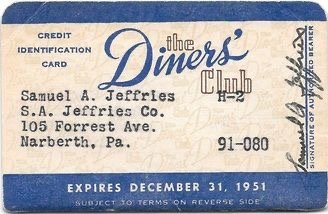1865: The Birth of the Concept
The first charge coins were issued, kickstarting modern credit card history. These coins allowed customers to pay at the time of the purchase without cash. They were tremendously popular in the farming industry in Western countries during westward expansion, allowing farmers to wait until after their harvest to pay their bills.
1882–1891: American Express
American Express, originally formed in 1850 to rival the U.S. Postal Service, introduced both money orders and travelers’ checks. Both gained popularity in the late 19th century.
1914: Loyalty
Department stores and oil companies began offering proprietary cards to customers, allowing them to buy goods on credit. These cards, predecessors to modern store cards, were much more about securing customer loyalty than offering purchasing convenience.
1946: Charge-It Card
John Biggins, a banker from Brooklyn, introduced the Charg-It card. The card worked on a local, closed-loop system, with all purchases being routed through Biggins’ bank. The bank paid for the purchase, and the customer paid for it through their account at Biggins’ bank later. Five years later, Franklin’s National Bank offered a similar card.
1950: Diners’ Club
The Diners’ Club card was launched after business executive Frank McNamara forgot his wallet during a client lunch. The cardboard card could be used for dining, entertainment, and travel expenses. Though it is considered the first widespread credit card, the Diners’ Club card operated like a charge card—at the end of each month, the bill had to be paid in full. It was also the first card to charge interest payments to its users.
1955: The Term “Credit Card”
The term “credit card” was used in a patent for the first time. This patent ushered in the first gas pump that accepted credit cards.
1958: Travel and Entertainment Card
American Express released their travel and entertainment card geared toward business people who traveled for work. This allowed them to pay for all their business expenses without carrying large sums of cash.
1958: Bank Cards
BankAmericard kickstarted the practice of banks offering cards working on revolving credit when they sent out 60,000 unsolicited cards in the mail in California. The introduction of revolving credit made early iterations into what we know as credit cards today. Customers could carry their remaining monthly balances forward for a fee. By 1966, the card became the first licensed general-purpose credit card.
1959: Plastic Credit Cards
American Express launched the first plastic card made out of PVC, greatly increasing the company’s popularity.
1966: MasterCharge
The Interbank Card Association was formed to stop BankAmericard from monopolizing the industry. The group sought to create the first national credit card system, issuing their card, the MasterCharge (modern-day MasterCard).
1967: ATM
A cash machine was put into use by Barclays Bank in Enfield, United Kingdom, on June 27, 1967, which is recognized as the world’s first ATM.
1968: MasterCard
The Interbank Card Association introduced credit card systems to Mexico, Europe, and Japan, making it the first global card company. This shift also ushered in a new name for the company: MasterCard.
1970: Magnetic Stripe
IBM introduced the magnetic stripe in conjunction with American Airlines and American Express. This form of data transfer prevailed for nearly 50 years but is now being phased out to make way for EMV chips and contactless payment methods.
1973: Advanced Technology
MasterCard and National BankAmericard developed their electronic authorization systems for credit card processing. These systems paved the way for the technologically advanced industry of today.
1976: VISA
BankAmericard expanded outside the United States and changed its name to Visa, now the most widely recognized credit card brand.
1981: Point-of-Sale (POS)
Hawaiian company Verifone developed its first point-of-sale (POS) machine, followed by its popular ZON terminal in 1983. Their machine ushered in widespread use of POS systems.
2014: Digital Cards
Apple introduced its originally unpopular mobile payment digital wallet, Apple Pay. Similar mobile and contactless payment options expanded throughout the 2010s, including Google Pay, Android Pay, Samsung Pay, and others.
2015: Chip Cards
Europay, Mastercard, and Visa partnered to create the EMV chip, which has become standard practice in the credit card processing industry. Chips offer greater security due to their single-use transaction codes.

